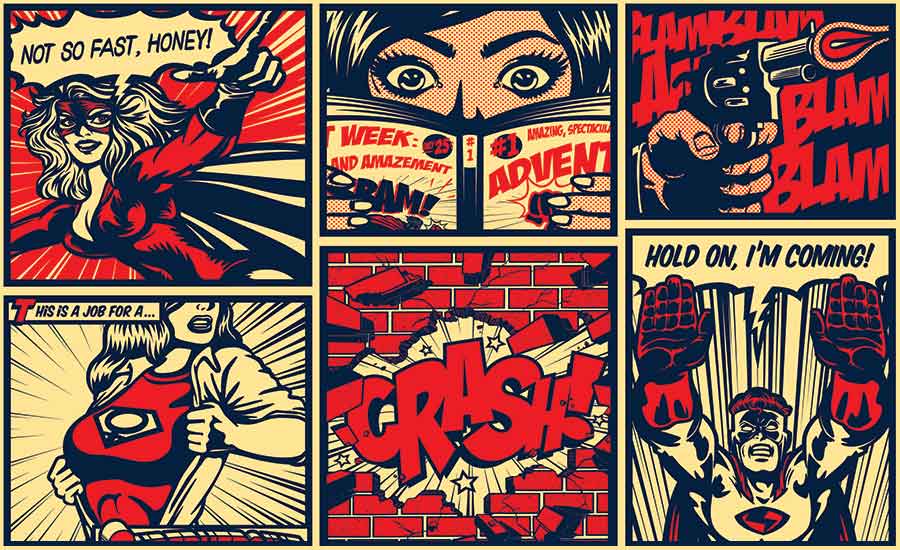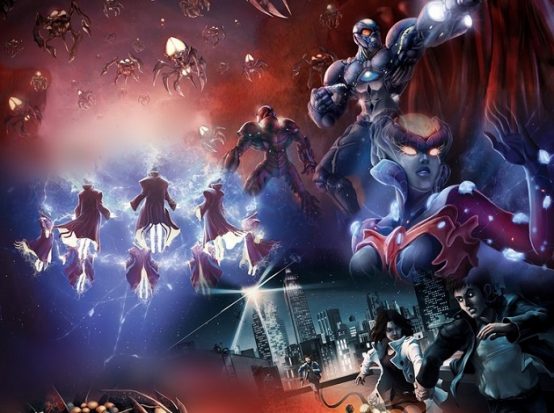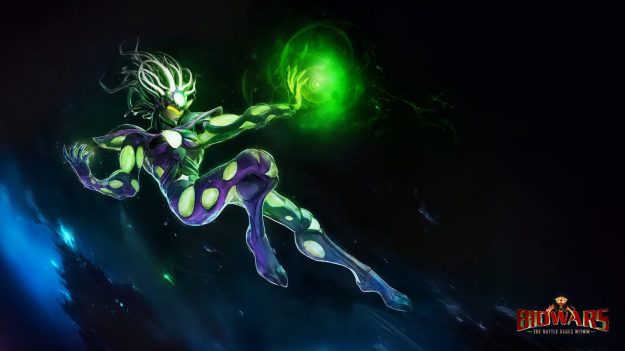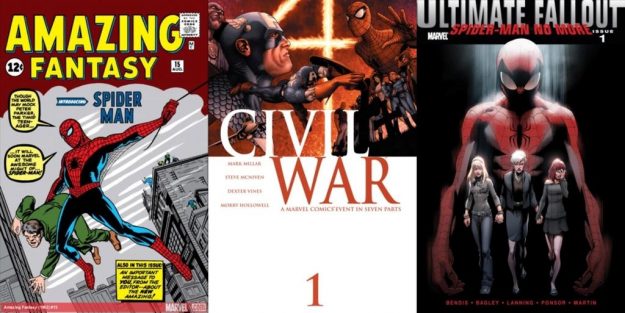Related Resources
The legendary comic book writer Stan Lee famously said:
“Comics are stories; they’re like novels or anything else. So, the first thing you have to do is become a good storyteller.”
And he was right.
But writing a compelling storyline is just one of the crucial ingredients of an excellent comic book.
You also need to create a storyboard, develop characters, establish what the central conflict should be… the list goes on.
If you’re new to creating comic books, you’ve come to the right place.
We’ll show you how to make a comic book step by step and share tips & tricks to help you get started ASAP.
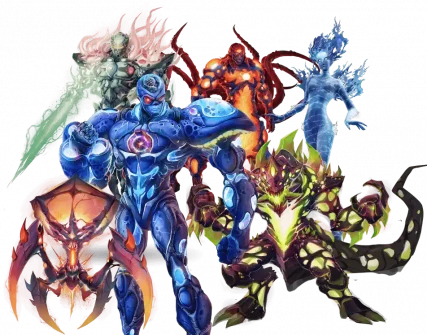
First Steps To Learning How To Make A Comic Book
One of the very first things to do while learning to make a comic book is to develop a concept for it.
After all, every piece of art starts with a good idea or concept, and comic books are no exception.
That’s how the BioWars comic book started, too, and it grew into a comic about the war that wages inside everyone us, between the BioWarriors — the protectors of the immune system — and pathogens.
Now, having an amazing idea is a great start, but you should develop it carefully before putting it on paper.
Here are the three fundamental steps you should follow after you come up with a concept for your comic book.
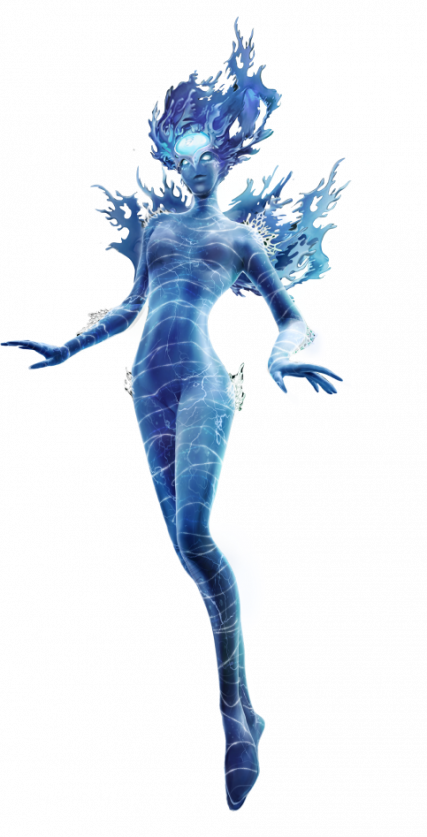
STEP #1: CREATE THE MAIN CONFLICT
If you were to join a screenwriting class, one of the first things you would hear is that at the heart of every story lies a conflict.
That comes as no surprise since conflict is only natural to human beings – and to comic book characters, too!
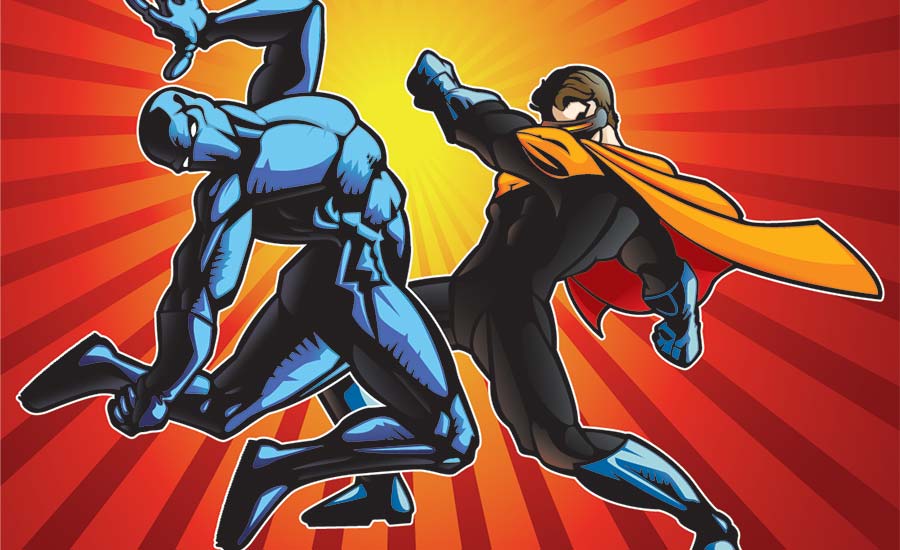
In comic books, the most common type of conflict is between the forces of good and evil.
Just think of Captain America vs. Red Skull, Batman vs. Joker, Superman vs. Lex Luthor and Spider-Man vs. the Green Goblin.
There are plenty more examples of comic book conflicts based on superhero vs. villain fights, but sometimes, that clash between good and evil may seem old and uninspiring.
Instead, consider exploring your superhero’s internal conflict: what’s the difference between their day-to-day and their superhero persona?
For instance, Peter Parker is a nerdy high school kid, often crippled with insecurities, but as Spider-Man, he is a powerful crime fighter.
He often questions his choices because he wants to be there for his friends and family, but he also knows that the lives of the innocent often depend on him.
Parker’s inner turmoil sometimes turns out to be too much to handle, causing Peter to abandon his superhero persona. For instance, when others questioned the righteousness of his actions or when his close ones were sick, he resigns from being Spider-Man.
Thor is another example of a superhero who, as a god of extreme power, for years felt unworthy and believed he didn’t earn the right to be the God of Thunder. He struggled with the feeling he had failed to make a difference in the world and found it hard to understand himself.
So, when creating a conflict, you can focus on describing the fight between two opposing forces, typically the protective vs. the destructive force. Or, you can write a story that describes how a superhero, be it a human, god, or mutant, struggles to make peace between their everyday and superhero personas.
STEP #2: CHOOSE AN APPROPRIATE SETTING FOR THE STORY
Once you’ve figured out the premise for your comic book storyline, the next step to learning how to make a comic book is to decide when and where the story takes place.
Perhaps your comic book could take place in deep space or several centuries into the future. You could also place your characters in the middle of an alternate-reality steampunk world. Or, you know, the good ole Earth, perhaps Scottsdale Arizona of today.
The choice is all yours — what matters is that you think of a setting that complements your characters and brings out of them exactly what you want readers to see.
If you wish to take your story one step further, you could consider expanding your original comic book into a whole universe, as Marvel famously did.
In doing so, you’ll be able to create even more characters and make more comic books that relate to one another as parts of a larger comic book world.
This is how spin-offs and crossovers usually happen — the storytelling potential becomes limitless when you create a whole universe or even multiple universes.
STEP #3: DECIDE ON THE MESSAGE YOU WANT YOUR COMIC TO CONVEY
After you get a good idea for the storyline, relatable characters and the unique universe where the plot of your comic book takes place, it’s time to dig a little deeper and decide on the main themes you want your story to reflect and the messages you’d like it to convey.
You can create a captivating story, but if there isn’t a meaningful message behind it or a reader can’t learn anything from it, it’s unlikely your comic book will make a real impact.
A meaningful message is to a story what seasoning is to a dish — it gives it taste and something a reader can think of and, ideally, get inspired by.
Why do you think Spider-Man comics got so popular with people of all ages and backgrounds?
Apart from taking readers on adventures alongside the world’s most popular superhero, Spider-Man comics teach readers that anyone can be a hero.
Even if you’re an average schoolkid, you can still make the lives of your loved ones just a little bit better — and you don’t need to be bitten by a radioactive spider to do so.
What matters is that you’re honest, kind, empathic and brave — these qualities that make Spider-Man the hero we all love, and not his ability to climb skyscrapers and shoot webs.
If you want your superhero story to be as inspirational as Spidey’s, try to think about what you really want your story to say.
What lessons or ideas do you want your reader to take from your comic?
Introduce Your Comic Book Characters
We mentioned earlier that readers mostly enjoy comic books that put a superhuman spin on ordinary people’s traits.
If it were any different, comic book characters would be unrelatable and, likely, forgettable.
If you were to put aside the otherworldly qualities of your favorite comic book characters and only focus on their basic personalities, you’d probably notice that you share some traits with them.
Superheroes, just like regular human beings, are complex.
And just like you, they have their share of ups and downs. Remember when Thor got fat during his alcoholic phase?
But how exactly do you create a relatable superhero?
And what are some supporting characters your comic book should feature?
STEP #4: CREATE THE HERO
In most comic books, the heroes are usually the bravest and the most selfless characters.
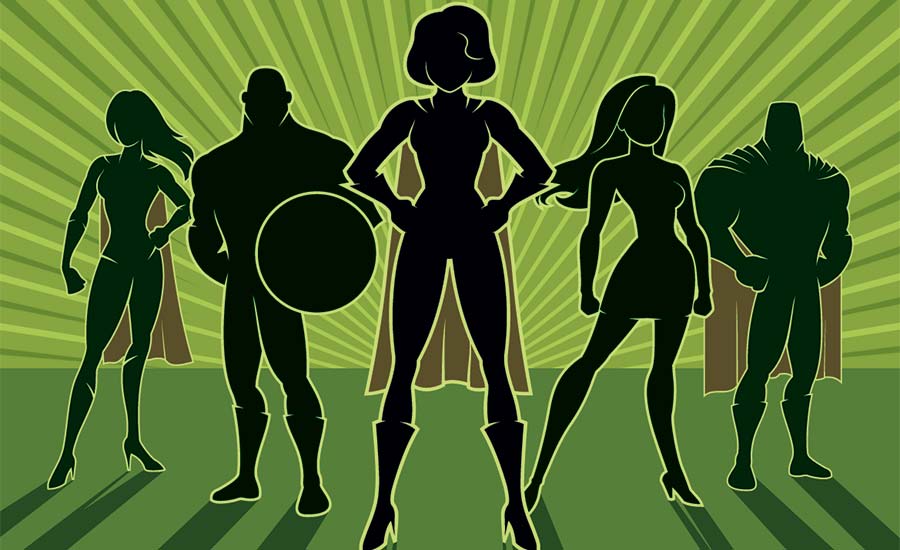
Like you, they go through personal struggles and may sometimes feel like going back to living an ordinary life.
But, despite the hardship they may face, heroes always find a way to rise above their challenges and use their intellect, powers and abilities to protect their ideals and those in need.
If you’ve ever read Batman comics or watched any of the Batman movies, you probably know how traumatized Batman is because of the tragedy he endured as a child. The past often haunts him, but still, he remains fiercely passionate and devoted to destroying evil in Gotham, turning his pain into his power.
So, when you start creating a superhero for your comic book, aside from their superpowers, you can also depict their flaws and weaknesses. Their human traits make them truly relatable, such as anger, compassion, bravery, clumsiness, insecurities, or stubbornness.
Just think of Deadpool, the beloved antihero. Sure, he is immortal and super strong, but the reason why the Deadpool movies have been such a great hit is his sarcasm, self-deprecating humor and metacommentary.
Another great example of a relatable superhero is Spider-Man. He struggles with insecurities and problems ordinary people have. Remember how anxious and self-conscious he gets when he tries to win Mary Jane’s heart? Or how he struggles to pay rent and often gets in trouble with his boss?
If you were to look past any superhero strengths, you’d realize that you and them are more alike than you may have thought.
And it’s exactly those traits that regular people like you and me have that make superheroes relatable.
STEP #5: INTRODUCE A VILLAIN
In most comic books, every heroic protagonist has at least one antagonist.
Just think of all Spider-Man’s archrivals, including Green Goblin and Kingpin.
Unlike heroes, who are willing to sacrifice themselves for the greater good, villains are usually all about getting what they want. And that usually means destroying everything on their path to reach their goal.
Nevertheless, just like the superheroes, the villains, too, tend to have a weakness that makes them vulnerable. Or they’ve suffered a traumatic event in the past that’s left them with an appetite for revenge and destruction.
Think of Doctor Doom, one of Marvel’s most powerful characters. He’s an almost tragic character because he never learned how to embrace himself.
Despite his great intellect, he felt insecure about a scar on his face. So, he hid behind a mask and chased great power, but he never found a way to overcome his insecurities and kept committing terrifying crimes.
But, not all villains are just that, inherently bad and egoistic.
In a lot of comic books, villains are complex characters that often blur the line between good and bad.
Think of Thanos, for example. He destroyed half of life on Earth, but he did so to save humanity.
Thanos knew about a Celestial growing beneath the Earth’s surface. He also knew that a Celestial would emerge once it got enough energy from the people living on the planet.
To prevent the Emergence from happening and the subsequent destruction of the Earth, Thanos wiped half of the planet’s life with a snap of his fingers.
There’s no doubt Thanos is a villain, but the writers purposely gave his character more nuance to show how means do not justify the end, no matter how noble that end may be.
STEP #6: THINK OF LEADING WITH AN ANTIHERO
Some comics feature antiheroes as central characters that are nothing like the superheroes or villains you may be used to.
You can have an antihero-only story or feature an antihero juxtaposed against a hero who becomes a secondary character (like Deadpool and Colossus).
Antiheroes aren’t necessarily brave, moral, or led by the same ideals as conventional superheroes. They often commit horrific deeds for purely personal reasons. However, antiheroes often feel the same sense of justice as superheroes, so they do all in their power to fight off the bad guys.
Remember Venom?
He started off as one of Spider-Man’s biggest enemies. He blamed Spidey for all his troubles and wanted to destroy him. Over time, though, he turned from a villain to an antihero, who even teamed up with Spidey on one occasion to destroy Carnage.
Deadpool is another example of a multi-layered antihero. When we meet him, he is a mercenary hired to scare or otherwise harm his contractor’s targets. He is also bullish and sarcastic even with the people he likes.
However, Deadpool sometimes wants to do the right thing. For example, in Marvel’s Dark Ages, the supervillain Apocalypse took over Europe. The Purple Man, his ally, could gain mind control over anyone he wanted, including Tony Stark. When a group of superheroes came to face Apocalypse, the Purple Man tried to get their minds under his control, but Deadpool jumped in and shot him in the head, saving not just the superheroes but also the entire planet.
Venom and Deadpool are both popular characters precisely because of the complexity of their personas and the fact they constantly teeter on the line between good and bad. As antiheroes, they challenge traditional comic book narratives. Their lack of a moral compass and the reluctance to obey societal expectations makes readers gravitate toward them because they feel free to do whatever they please.
STEP #7: CONSIDER BRINGING IN THE LOVE INTEREST
Nearly every character in comic book history — be it good or evil — has fallen in love at some point.
Some of everyone’s favorite superhero couples include Spider-Man and Mary Jane Watson, Iron Man and Pepper Potts, and one of the most popular LGBTQ pairs — Batwoman and The Question.
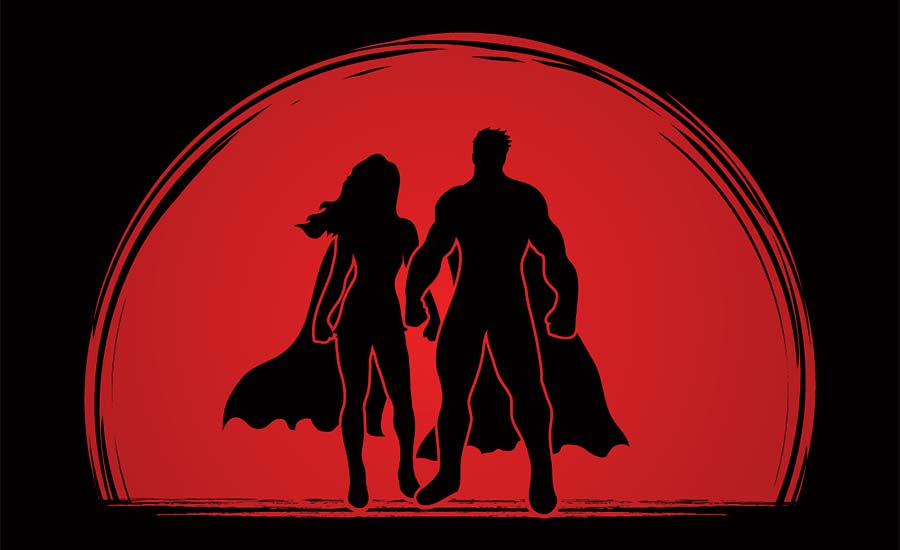
Depending on the topic of your comic book, perhaps adding a love interest to the story may feel unnecessary. But if there’s room for a bit of a love story in there, don’t hesitate to sprinkle some romance on your characters to make them even more realistic and appealing to readers.
STEP #8: MAKE ROOM FOR THE FAITHFUL COMPANION
Most lead comic book characters have a companion by their side, sticking with them through thick and thin.
Sure, they help heroes fight off the bad guys, but they more than just physically aid their superhero friend.
In most comic books, sidekicks act as a brother/sister or a father/mother to a hero or a villain, offering them valuable advice and moral support.
However, this isn’t necessarily how it should be and you shouldn’t limit your imagination.
It’s perfectly fine to have a superhero falter and the sidekick rise to the occasion as a way of inspiring all those kids who feel eclipsed by their siblings or friend.
Remember when Hit Girl was a sidekick to Kick-Ass? She was, in fact, more powerful than him and taught him how to fight. Without her, he wouldn’t be able to fight criminals. Hit Girl also showed Kick-Ass how to be a regular kid.
STEP #9: INTRODUCE THE ADVISOR
It’s not often you find a comic book hero who doesn’t have an influential mentor at some point in the storyline.
Of course, we don’t have to search far and wide for an example — there is hardly a better one than Aunt May and the wisdom she shares with Peter Parker.
Advisors are frequently part of a hero’s origin story. They encourage them to discover a meaningful purpose in their life and help them hone their powers.
Did you notice that villains never have someone to advise them and help them become better versions of themselves?
In fact, having an advisor is one of the things that sets the good guys apart from the bad, since most villains don’t have anyone guiding them. And that’s fine for plots based on the superhero vs. the villain dynamics — if all villains turned sides, who would there be left to fight?
Create A Storyboard
In one of our previous blogs, we talked about comic book storyboards, highlighting their importance.
But we cannot resist mentioning them again, because storyboarding is one of the most useful techniques you should use when learning how to create your comic book.
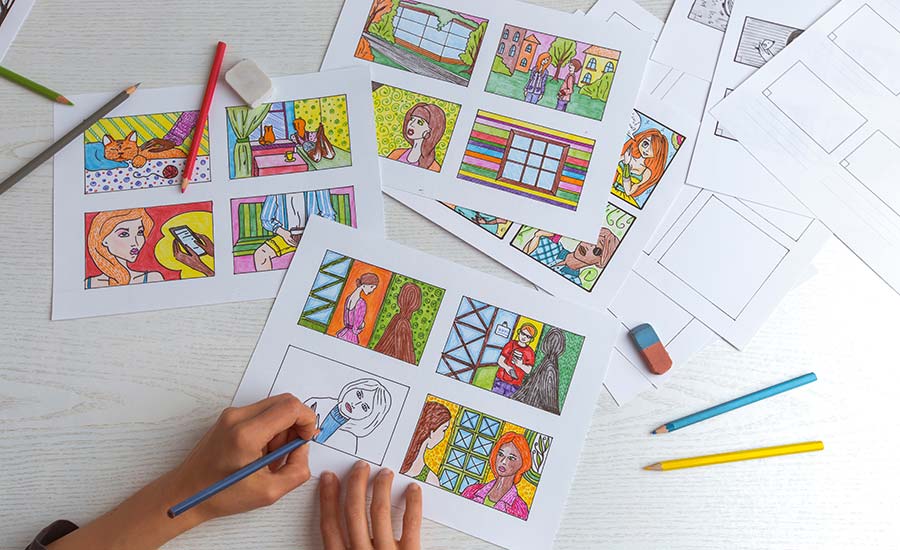
In a nutshell, a storyboard is a frame-by-frame outline of a scene or sequence of scenes within your comic book.
In addition to comic books, storyboarding is used in almost all genres of visual media, including movies, TV shows, video games and even music videos.
Each storyboard frame typically includes a rough sketch of what a frame will look like, along with additional comments and directions.
Storyboarding is the first step to visualizing your comic book and its elements, including characters, settings, dialogues, backgrounds, and so on.
But to learn about storyboarding in great depth, be sure to check out our dedicated blog post!
Choose An Online Comic Book Maker
When you come this far, you should have the basis of your comic book and its key elements figured out. All that’s left is to start creating your comic book!
If you prefer pencil and paper, check out our guides on how to draw a character, how to draw a face , and how to draw hands to help you get started with your characters.
Alternatively, you can use one of the three online comic book makers below to bring your ideas to life!
TOOL #1: MAKEBELIEFSCOMIX
Geared towards adults and kids, MakeBeliefsComix gives you access to dozens of colorized characters, animals and backgrounds. You have the possibility to create your comic strip and share your story in up to 18 panels.
This free platform also allows you to create comics in several languages, which is great for building a global community of comic fans.
The comic book maker’s real upside is the simplicity of the creative process, allowing you to wrap things up in as little as 10-15 minutes!
Make Belief Comix includes some pretty cool features, such as:
- Tutorial: Before you start using the platform, we recommend watching a helpful tutorial to understand how you can create a comic book using the Make Belief Comix platform.
- Story Ideas: If you don’t know how to start writing a story for your comic book, you can use some of the story prompts featured on the platform.
- Gallery: If you’d like to share your comic book creations with others on the platform, you can mail your art to the platform and have it uploaded to the site’s gallery. Also, you can build your Comic Art Portfolio by saving your comic book strips.
TOOL #2: CANVA

Canva is a free drag-and-drop platform many people use to create visually appealing projects.
However, not everyone’s aware that Canva is also a powerful online comic book maker! The platform is quite multifunctional and has a rich library of presets and layouts.
Canva also allows you to experiment with shapes, text and videos and to upload your own images.
The latter feature is particularly handy since Canva, unfortunately, doesn’t allow you to draw within the platform.
Nevertheless, we recommend you try Canva out since it has enough options any beginner comic book artist may need.
You can choose between three plans:
- Free: The free Canva plan gives you access to more than 250,000 free templates and more than one million free photos and graphics.
- Pro: The pro plan offers more flexibility compared to the free trial and access to more than 100 million photos, videos and templates. The current price for the Pro plan is $119.99 per person per year.
- Team: As its name suggests, Canva Team is a plan for teams of all sizes that allows for collaborative creative work. It costs $300 per year for the first five team members.
TOOL #3: PIXTON
Pixton is an easy-to-use platform intended for teachers and students. Yep, if you’re a teacher, you can use this terrific platform to teach with comics.
For example, as a teacher, you can filter the content by:
- Grade Level (from grade 1 – 12)
- Subject (History, Math, Science, etc.)
- Objective (analysis, evaluation, critical thinking, etc.)
Pixton is highly customizable, allowing you to experiment with characters’ features, including their clothes, facial features and their overall appearance.
You can also change the size and shape of the entire Pixton world.
The possibility to drag and drop characters into positions you desire makes your job of creating a comic book much easier and faster.
With Pixton, there really is no end to what you can create in a few minutes or hours.
On top of this, Pixton allows you to add photos from Flickr or Google Images and use them as panel backgrounds.
Unlike MakeBeliefComix and Canva, Pixton isn’t free. You can try the free trial mode to test it out, but if you’re serious about using it in the long run, be prepared to spend at least $144 per year on a subscription.
Wrapping Up On How To Make A Comic Book
Learning how to create a comic book might seem like a huge effort since there are many elements to consider and decide on, including characters, themes, plotlines, typography and colors.
The good news is that the whole process can be much easier, if you follow the key steps outlined above:
- Start by developing your idea and think of the message you wish your comic book to convey
- Work on developing main and side characters
- You should make your characters relatable
- Use storyboarding to develop your concept for a comic
- Bring your ideas to life using an online comic book maker of your choice
Moreover, don’t hesitate to ask others for help.
You may be a great storyteller or an excellent illustrator, but perhaps you feel like you lack skill in other areas. Consider hiring creatives who can help you make a comic book exactly how you imagined it.

